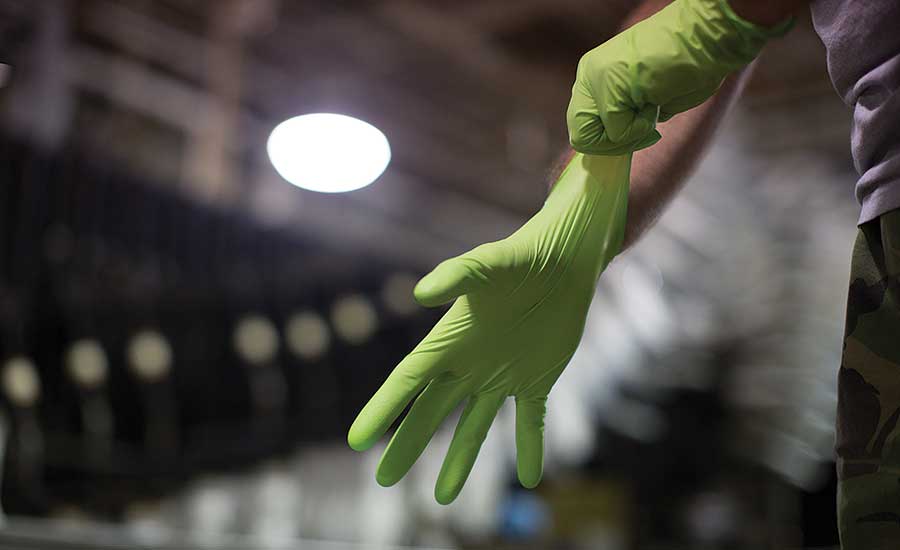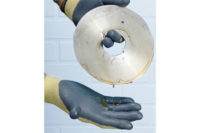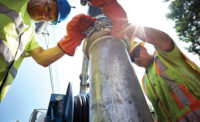Industrial process environments where workers must wear PPE gloves are becoming increasingly controlled. While protecting the wearer from chemical exposure, gloves for cleanrooms must not introduce any contaminants into the space.
The evolving standard for these applications is powder-free, silicone-free, latex-free gloves such as single-use, disposable nitrile-based products that undergo a chlorination treatment, a deionized water wash and cleanroom drying and packing. The level of particles – most of which emanate from human skin, clothing and hair – and extractables must be kept to an absolute minimum.
Tasks and risks dictate design
Working with flammable liquids and gases, for example, calls for gloves that prevent electrostatic discharge (ESD) or buildup, which can damage electrical components and even ignite those flammable fluids. Laboratory workers, as well as those in the food and automotive industries, need thicker gloves – in the 8-mil range – to resist chemical penetration or permeation.
Multiple-length glove options have become necessary as well, given that handling hazardous chemicals (e.g., chemotherapy drugs) makes a longer-length glove better for covering more of the forearm – including overlapping the sleeve – and keeping it safe from exposure
The advantages of nitrile
Critical process environments also demand that people handle products with the greatest of care. Obviously, spills and drops can cause breakage or infiltration that can contaminate the environment or product. Disposable nitrile rubber gloves afford the gripping dexterity and fatigue-lessening comfort and feel that sharply reduce the risk of clumsiness and accidents. (Finger movement flexibility is superior to latex, making these gloves a good fit for pharmaceutical applications such as vaccine and enzyme production.) Since they also offer better abrasion resistance than latex, they’re a safer bet for maintaining critical environments that must be free of RNA, which is more likely to degrade than DNA and is readily sloughed off human skin.
The industry continues to improve on groundbreaking material, such as technology to increase the tensile strength of nitrile cleanroom gloves so that they have enhanced barrier protection and puncture resistance. Nitrile gloves with minimal electrostatic current are relatively new options for preventing ESD harm to sensitive manufacturing tools and machines.
Importance of comfort
While its imperviousness to punctures and chemical, biological and radioactive substances make it a preferred disposable glove material for cleanrooms and other controlled environments, nitrile’s real benefit is comfort. Glove makers often apply vanguard nitrile-based manufacturing processes to hybridize the protection of nitrile with the touch sensitivity of rubber latex.
Since cleanroom workers usually wear cumbersome garments, apparel manufacturers are looking for ways to make them less restrictive and permit easier, more nimble motions. Gloves that require less direct hand and forearm muscle exertion fit the bill.
Rigorous test and standards
The qualification of gloves for cleanroom usage in high-tech manufacturing environments involves rigorous testing to ensure that the gloves can protect products from contamination or ESD. A new industry report describes how dipped film gloves may be subjected to contact stain and near-contact stain tests. The test glove material is placed in a temperature/relative humidity chamber and held against or close to the product. The materials pass muster if they are free from stains, discoloration or corrosion and then undergo objective laboratory tests that measure for extractable particles, ions and organic elements.
Cleanrooms have different designations to mark their levels of cleanliness – e.g., Class 1, Class 10, Class 100 – and industry standards stipulating maximum allowable numbers of particulates per cubic foot for those designations. So, it’s important that the gloves chosen for cleanroom use have particle counts that aren’t greater than the maximum standard for that facility.
Acceptable Quality Levels (AQLs) are numerical product standards that health authorities stipulate for medical gloves. It’s one more way in which the bar has been raised for critical environment-safe gloves.
The norm used to be that a medical glove had to have a 1.5 AQL. Now, it’s likely down to .65 — effectively, more than cut in half — in most facilities. Whether it’s a medical device area, cleanroom or pharmaceutical lab, the demands have risen across the board.
Role of packaging
Glove packaging is no less important than glove materials and properties in ensuring the gloves’ acceptability for cleanrooms and other critical environments. Since uncoated chipboard dispenser boxes can throw off particles and contaminate gloves, dispenser-boxed gloves that protect the wearer are free of powder but not particles. They also may contain additives or fillers that reduce the surface resistivity to ESD and compromise glove cleanliness.
Gloves that are flat packaged, doubly-poly bagged and vacuum-sealed, with all cuffs at one end (to avoid contaminating bare hand contact with any glove part except the cuff), lessen the packaging risk to pristine maintenance of environments in which all atmospheric and material factors must be strictly controlled.


